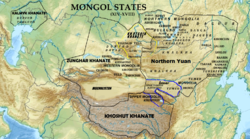Kalmyk Khanate
| Kalmyk Khanate | ||||||||
| khanate | ||||||||
|
||||||||
|
The Kalmyk Khanate in the 17th century.
|
||||||||
| Capital | Not specified | |||||||
| Languages | Kalmyk language | |||||||
| Religion | Tibetan Buddhism | |||||||
| Government | Hereditary monarchy | |||||||
| President | ||||||||
| • | died 1644 | Kho Orluk | ||||||
| • | 1669–1724 | Ayuka Khan | ||||||
| History | ||||||||
| • | Established | 1630 | ||||||
| • | Annexed by Russia | 1771 | ||||||
|
||||||||
The Kalmyk Khanate was an Oirat khanate on the Eurasian steppe. It covered the area called Kalmykia and the surrounding areas stretching from Stavropol to Astrakhan. For over a hundred years the Kalmyk alternately raided the southern borderlands of Russia but also protected southern borders of Russia and engaging in many military expeditions against the Muslim tribes of Central Asia, the North Caucasus and Crimea. The Kalmyk conducted many military expeditions against the Crimean Tatars, Ottoman Empire and Kuban Tatars and also waged wars against the Kazakhs, subjugated the Mangyshlak Turkmens, and made multiple expeditions against the highlanders of the North Caucasus. The Khanate was annexed by the Russian Empire in 1771.
Upon arrival to the lower Volga region in 1630, the Oirats encamped on land that was once part of the Astrakhan Khanate, but was now claimed by the Tsarist government. The region was lightly populated, from south of Saratov to the Russian garrison at Astrakhan and on both the east and the west banks of the Volga River. The Tsarist government was not ready to colonize the area and was in no position to prevent the Oirats from encamping in the region. But it had a direct political interest in insuring that the Oirats would not become allied with its Turkic-speaking neighbors.
The Oirats quickly consolidated their position by expelling the majority of the native inhabitants, the Nogai Horde. Large groups of Nogais fled southeast to the northern Caucasian plain and west to the Black Sea steppe, lands claimed by the Crimean Khanate, itself a vassal or ally of Ottoman Turks. Smaller groups of Nogais sought the protection of the Russian garrison at Astrakhan. The remaining nomadic tribes became vassals of the Oirats.
At first, an uneasy relationship existed between the Russians and the Oirats. Mutual raiding by the Oirats of Russian settlements and by the Cossacks and the Bashkirs (Muslim vassals of the Russians) of Oirat encampments was commonplace. Numerous oaths and treaties were signed to ensure Oirat loyalty and military assistance. Although the Oirats became subjects of the Tsar, such allegiance by the Oirats was deemed to be nominal.
...
Wikipedia

